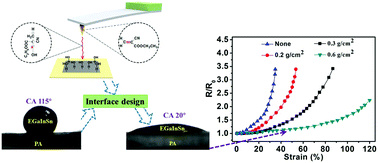Interface design for enhancing the wettability of liquid metal to polyacrylate for intrinsically soft electronics†
Abstract
Ga-Based liquid metal (Ga-LM) alloys with high conductivities and low Young's moduli have attracted great attention, owing to their huge potential for replacing high Young's modulus metals (gold (Au), silver (Ag), copper (Cu), etc.) and fabricating next-generation intrinsically stretchable electronics. However the simultaneous achievement of excellent stretchability and stable conductivity has been a significant challenge for preparing Ga-based LM intrinsically stretchable electronics on the grounds of the weak interfacial adhesion between Ga-LM and soft substrates. Herein, a novel adhesive interface structure between liquid eutectic gallium indium stannum (EGaInSn) and polyacrylate (PA) for simultaneously achieving high stretchability and stable conductivity is reported and their high performance as intrinsically stretchable electronics is demonstrated. The design of the interface structure follows the facile polymerization of ethyl-2-cyanoacrylate, which is triggered by water molecules sticking on the surface of gallium oxide. It was found that the interfacial polymerization not only forms an effective adhesion network but also removes the water molecules, resulting in a good bonding interface with a low resistivity of 1.3 × 10−6 Ω m and stable conductivity at tensile strains of up to 80%. The desirable intrinsically stretchable conductor is comparable to recently reported conductors, which together with the advantages of a high match for the Young's modulus and low resistivity makes it attractive for various electronic devices.



 Please wait while we load your content...
Please wait while we load your content...